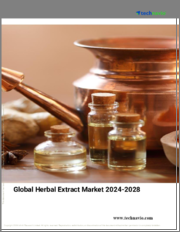
|
시장보고서
상품코드
1389884
세계의 허브 추출물 시장 : 원료별, 형태별, 용도별, 지역별 평가, 기회 및 예측(2016-2030년)Herbal Extract Market Assessment, By Source, By Form, By Application, By Region, Opportunities, and Forecast, 2016-2030F |
||||||
세계 허브 추출물 시장 규모는 2022년 305억 1,000만 달러로 평가되었고, 2023년부터 2030년까지 예측 기간 동안 10.2%의 CAGR을 나타내고, 2030년에는 663억 6,000만 달러로 성장할 것으로 예상됩니다. 식음료 산업의 성장은 영양 강화 식품에 대한 수요 증가, 패스트푸드 채택률 증가, 고도의 자동화 제조 시설 개발 등의 변수에 기인합니다. 또한, 신약 개발을 위한 연구개발 활동 증가와 새로운 제조 시설에 대한 투자 증가는 의약품 생산을 촉진하고 있습니다. 향후 식음료 및 제약 산업의 견조한 성장은 항균성이 뛰어난 바질, 민트, 알로에베라와 같은 허브 추출물에 대한 수요를 촉진하여 시장 성장을 가속할 것으로 예상됩니다. 또한, 최근 출범한 허브 추출물 제조 시설은 세계 시장에서의 제품 공급을 촉진하여 예측 기간 동안 허브 추출물 산업에 유리한 성장 기회를 창출할 것으로 예상됩니다. 예를 들어, 2023년 7월 인도의 원료 공급업체인 매니팔 그룹(Manipal Group)은 인도 카르나타카 주 다바스펫(Dabaspet) 산업 지역에 새로운 허브 추출물 제조 공장을 설립할 계획을 발표했습니다. 공장 부지면적은 10만 평방피트, 처리 능력은 하루 30톤입니다. 한편, 원자재 가격의 변동은 허브 추출물 시장의 성장을 억제하고 있습니다.
본 보고서는 세계의 허브 추출물 시장에 대해 분석했으며, 제품 개요와 시장의 기본 구조, 전체 시장 규모 동향 전망, 부문별/지역별 상세 동향, 시장 배경 상황과 주요 영향요인, 주요 기업 개요와 시장 점유율 등의 정보를 전해드립니다.
목차
제1장 조사 방법
제2장 프로젝트의 범위와 정의
제3장 주요 요약
제4장 고객의 견해
- 시장 인식과 제품 정보
- 브랜드 인지도와 로열티
- 구입 의사결정시에 고려되는 요소
- 구입 빈도
- 구입 수단
제5장 허브 추출물 시장 전망(2016년-2030년)
- 시장 규모와 예측
- 금액 기준
- 수량 기준
- 원료별
- Neem
- 헤나
- 샌들우드
- 바질
- 민트
- 알로에
- 타임
- 로즈마리
- 라벤더
- 기타
- 형태별
- 분말
- 액체
- 겔
- 용도별
- 화장품 및 퍼스널케어
- 스킨케어
- 헤어케어
- 향료 및 향수
- 기타
- 식품 및 음료
- 유제품
- 베이커리 제품
- 제과 제품
- 음료
- 기타
- 의약품
- 동물사료
- 방충제
- 기타
- 화장품 및 퍼스널케어
- 지역별
- 북미
- 유럽
- 남미
- 아시아태평양
- 중동 및 아프리카
- 기업별 시장 점유율(%, 2022년)
제6장 허브 추출물 시장 전망 : 지역별(2016년-2030년)
- 북미
- 시장 규모와 예측
- 금액 기준
- 수량 기준
- 원료별
- 형태별
- 용도별
- 미국
- 시장 규모와 예측
- 원료별
- 형태별
- 용도별
- 캐나다
- 멕시코
- 시장 규모와 예측
각 부문의 정보는 대상이 되는 모든 지역과 국가에 대해 제공됩니다.
- 유럽
- 독일
- 프랑스
- 이탈리아
- 영국
- 러시아
- 네덜란드
- 스페인
- 터키
- 폴란드
- 남미
- 브라질
- 아르헨티나
- 아시아태평양
- 인도
- 중국
- 일본
- 호주
- 베트남
- 한국
- 인도네시아
- 필리핀
- 중동 및 아프리카
- 사우디아라비아
- 아랍에미리트(UAE)
- 남아프리카공화국
제7장 공급측 분석
- 생산능력 : 기업별
- 생산량 : 기업별
- 운영 효율 : 기업별
- 주요 공장 소재지(25위까지)
제8장 시장 매핑(2022년)
- 원료별
- 형태별
- 용도별
- 지역별
제9장 거시환경과 산업 구조
- 수급 분석
- 수출입 분석(수량/금액 기준)
- 공급/밸류체인 분석
- PESTEL 분석
- Porter의 Five Forces 분석
제10장 시장 역학
- 성장 촉진요인
- 성장 억제요인(과제, 제약)
제11장 주요 기업 상황
- 시장 리더 주요 5개사 : 경쟁 매트릭스
- 시장 리더 주요 5개사 : 시장 매출 분석(%, 2022년)
- 기업인수합병(M&A)/합작투자(해당하는 경우)
- SWOT 분석(시장 진출기업 5개사의 경우)
- 특허 분석(해당하는 경우)
제12장 가격 분석
제13장 사례 연구
제14장 주요 기업 전망
- Symrise
- 기업 개요
- 경영 임원
- 제품 및 서비스
- 재무 상황(보고된 대로)
- 중점 시장과 지역 존재감
- 최근 동향
- Robertet Groupe
- Sami Spices(Sami-Sabinsa Group Limited)
- Dohler GmbH
- Synthite Industries Ltd.
- Mane KANCOR
- Firmenich SA
- FLAVEX Naturextrakte GmbH
- SA Herbal Bioactives LLP
- Ransom Naturals Ltd.
상기 기업은 시장 점유율 순서가 아니며, 조사 작업 중에 입수한 정보에 따라서 변경될 가능성이 있습니다.
제15장 전략 제안
제16장 Market Xcel에 대해/면책사항
LSH 23.12.12Global herbal extract market size was valued at USD 30.51 billion in 2022, which is expected to grow to USD 66.36 billion in 2030 with a CAGR of 10.2% during the forecast period between 2023 and 2030. The growth of the food and beverage industry is attributed to variables, including increasing demand for nutrient-enriched food, rising adoption of fast food, and the development of advanced automated manufacturing facilities. Also, increasing research and development activities for new drug discovery and rising investments in new manufacturing facilities are propelling the production of pharmaceuticals. Henceforth, the robustly expanding food and beverage and pharmaceutical industry is fuelling the demand for herbal extracts such as basil, mint, and aloe vera due to their superior antimicrobial properties, which is driving the market growth. In addition, the recently launched herbal extract manufacturing facilities will boost the supply of products in the global market, thereby creating a lucrative growth opportunity for the herbal extract industry during the projected forecast period. For illustration, in July 2023, Manipal Group, an ingredient supplier in India announced its plans to open a new herbal extracts manufacturing plant in Dabaspet Industrial Area, Karnataka, India. The factory will be spread across an area of 100,000 square-foot area and will have a processing capacity of 30 metric tons per day. However, the fluctuating raw materials prices are restraining the herbal extract market growth.
Prospering Food & Beverage Sector is Supplementing the Market Growth
Herbal extracts are ideal for the food & beverage industry to boost the immune system and increase the vitamin content. Herbal extracts are utilized in food & beverage products such as bakeries, dairy, and beverages to increase the antioxidant properties of the products. The growth of the food & beverage industry is accredited to prominent elements such as the recent trend for the rising intake of nutritional food content and the increasing sales of specialty food products through online sales channels.
According to the recent data published by the Specialty Food Association, Inc., in 2022, the specialty food products industry in the United States was valued at USD 194 billion, an annual growth rate of 9.3%. In addition, according to the recent statistics published by Food Drink Europe, a European Union food and beverage association, the European Union food & beverage sector turnover registered an annual growth rate of 2.6%, reaching USD 1,180.5 billion in 2022. Likewise, according to Invest India, the Indian food processing industry will reach USD 535 billion, registering a CAGR of 15.2% in 2025. Therefore, the booming food & beverage industry is spurring the demand for herbal extract to increase the flavor of the food products, thereby driving the market growth.
The Recently Developed Herbal Extract Manufacturing Facilities to Augment Market Growth
The various players in the herbal extract market are leveraging their investments to develop new production plants to expand their market share globally. The increase in the production of herbal extracts will foster product availability in various regions, thereby creating a favorable potential for market growth in the upcoming years.
For illustration, in May 2023, Vidya Herbs Pvt. Ltd., a global manufacturer of herbal products, launched a new herbal manufacturing plant in the United States. The herbal extract will be manufactured for end-use industries such as cosmetics & personal care and pharmaceuticals. As a result, the recently opened herbal extract manufacturing facilities will propel product availability for various end users, accelerating market growth in the coming years.
Dominant Share of the Asia-Pacific in the Overall Market
The Asia Pacific regional economy has significant market traction from industries, including food & beverage, cosmetics & personal care, and pharmaceuticals. The above industries are the major end users of herbal extract, leading to increased demand for thyme, rosemary, and lavender-based extracts in the Asia-Pacific. The recently developed food & beverage manufacturing facility, rapid demand for packaged food, and the recent launch of processed food products with herbal extract ingredients are the prime factors boosting the revenue expansion of the food & beverage industry in the Asia-Pacific.
For instance, according to the recent statistics published by the China National Development and Reform Commission, in 2021, the China agricultural & sideline food processing and food manufacturing sector registered a year-on-year growth rate of 7.7% and 8%, respectively. In addition, according to Invest India, a government of India website, the food processing sector in India is projected to reach USD 535 billion and register a compound annual growth rate of 15.2%. The tier-II and tier-III cities will showcase the same trend visible in metropolitan areas as the consumption of processed food will increase in the upcoming years. Henceforth, the bolstering food & beverage industry in the Asia-Pacific is driving the demand for herbal extract, amplifying the region's market growth.
Future Outlook Scenario
The entry of international players in emerging economies and the rising demand for dairy products will accelerate the food & beverage industry, which, in turn, will augment the herbal extract market growth in the coming years. According to the recent data published by Invest India, the food processing sector in India will reach USD 535 billion, with a CAGR of 15.2% in 2025.
The recent partnerships between the herbal extract manufacturers and chemical distributors to cater to the demand from various end-use industries will create a lucrative potential for the herbal extract market growth in the long run. For instance, in June 2023, Plantapharm, an Austria-based manufacturer of herbal extract, formed a partnership with Nordmann, Rassmann GmbH., a leading Europe-based chemical supplier for the distribution of Nordmann herbal extract products in countries such as Romania, Bulgaria, and Serbia.
The growth of the online sales channel in the upcoming years will boost the presence of herbal extract products in the market, thereby creating a favorable potential for market growth during the forecast period. For instance, according to Shopify, a global e-commerce site, approximately 21.2% of retail sales will be online through company-owned websites and third-party e-commerce sites by 2024.
Key Players Landscape and Outlook
The herbal extract industry is a highly competitive market due to the presence of several large conglomerates along with various small & medium-sized companies. The market players have strong product development capabilities and a wide range of presence in the global market through their diverse product portfolios and sales channels. The herbal extract companies focus on increasing their product offerings through partnerships, mergers, and acquisitions.
In May 2022, Leaven Essentials, an India-based manufacturer of herbal extract, launched Botanical Extracts. The primary focus of the launch was to increase the presence of Leaven Essentials products in the global market.
Table of Contents
1. Research Methodology
2. Project Scope & Definitions
3. Executive Summary
4. Voice of Customer
- 4.1. Market Awareness and Product Information
- 4.2. Brand Awareness and Loyalty
- 4.3. Factors Considered in Purchase Decision
- 4.3.1. Brand Name
- 4.3.2. Quality
- 4.3.3. Quantity
- 4.3.4. Price
- 4.3.5. Product Specification
- 4.3.6. Form Specification
- 4.3.7. Shelf Life
- 4.3.8. Availability of Product
- 4.4. Frequency of Purchase
- 4.5. Medium of Purchase
5. Herbal Extract Market Outlook, 2016-2030F
- 5.1. Market Size & Forecast
- 5.1.1. By Value
- 5.1.2. By Volume
- 5.2. By Source
- 5.2.1. Neem
- 5.2.2. Henna
- 5.2.3. Sandalwood
- 5.2.4. Basil
- 5.2.5. Mint
- 5.2.6. Aloe Vera
- 5.2.7. Thyme
- 5.2.8. Rosemary
- 5.2.9. Lavender
- 5.2.10. Others
- 5.3. By Form
- 5.3.1. Powder
- 5.3.2. Liquid
- 5.3.3. Gel
- 5.4. By Application
- 5.4.1. Cosmetics & Personal Care
- 5.4.1.1. Skincare
- 5.4.1.2. Haircare
- 5.4.1.3. Perfumery & Fragrance
- 5.4.1.4. Others
- 5.4.2. Food & Beverages
- 5.4.2.1. Dairy Products
- 5.4.2.2. Bakery Products
- 5.4.2.3. Confectionery Products
- 5.4.2.4. Beverages
- 5.4.2.5. Others
- 5.4.3. Pharmaceuticals
- 5.4.4. Animal Feed
- 5.4.5. Insect Repellent
- 5.4.6. Others
- 5.4.1. Cosmetics & Personal Care
- 5.5. By Region
- 5.5.1. North America
- 5.5.2. Europe
- 5.5.3. South America
- 5.5.4. Asia-Pacific
- 5.5.5. Middle East and Africa
- 5.6. By Company Market Share (%), 2022
6. Herbal Extract Market Outlook, By Region, 2016-2030F
- 6.1. North America*
- 6.1.1. Market Size & Forecast
- 6.1.1.1. By Value
- 6.1.1.2. By Volume
- 6.1.2. By Source
- 6.1.2.1. Neem
- 6.1.2.2. Henna
- 6.1.2.3. Sandalwood
- 6.1.2.4. Basil
- 6.1.2.5. Mint
- 6.1.2.6. Aloe Vera
- 6.1.2.7. Thyme
- 6.1.2.8. Rosemary
- 6.1.2.9. Lavender
- 6.1.2.10. Others
- 6.1.3. By Form
- 6.1.3.1. Powder
- 6.1.3.2. Liquid
- 6.1.3.3. Gel
- 6.1.4. By Application
- 6.1.4.1. Cosmetics & Personal Care
- 6.1.4.1.1. Skincare
- 6.1.4.1.2. Haircare
- 6.1.4.1.3. Perfumery & Fragrance
- 6.1.4.1.4. Others
- 6.1.4.2. Food & Beverages
- 6.1.4.2.1. Dairy Products
- 6.1.4.2.2. Bakery Products
- 6.1.4.2.3. Confectionery Products
- 6.1.4.2.4. Beverages
- 6.1.4.2.5. Others
- 6.1.4.3. Pharmaceuticals
- 6.1.4.4. Animal Feed
- 6.1.4.5. Insect Repellent
- 6.1.4.6. Others
- 6.1.5. United States*
- 6.1.5.1. Market Size & Forecast
- 6.1.5.1.1. By Value
- 6.1.5.1.2. By Volume
- 6.1.5.2. By Source
- 6.1.5.2.1. Neem
- 6.1.5.2.2. Henna
- 6.1.5.2.3. Sandalwood
- 6.1.5.2.4. Basil
- 6.1.5.2.5. Mint
- 6.1.5.2.6. Aloe Vera
- 6.1.5.2.7. Thyme
- 6.1.5.2.8. Rosemary
- 6.1.5.2.9. Lavender
- 6.1.5.2.10. Others
- 6.1.5.3. By Form
- 6.1.5.3.1. Powder
- 6.1.5.3.2. Liquid
- 6.1.5.3.3. Gel
- 6.1.5.4. By Application
- 6.1.5.4.1. Cosmetics & Personal Care
- 6.1.5.4.1.1. Skincare
- 6.1.5.4.1.2. Haircare
- 6.1.5.4.1.3. Perfumery & Fragrance
- 6.1.5.4.1.4. Others
- 6.1.5.4.2. Food & Beverages
- 6.1.5.4.2.1. Dairy Products
- 6.1.5.4.2.2. Bakery Products
- 6.1.5.4.2.3. Confectionery Products
- 6.1.5.4.2.4. Beverages
- 6.1.5.4.2.5. Others
- 6.1.5.4.3. Pharmaceuticals
- 6.1.5.4.4. Animal Feed
- 6.1.5.4.5. Insect Repellent
- 6.1.5.4.6. Others
- 6.1.6. Canada
- 6.1.7. Mexico
- 6.1.1. Market Size & Forecast
All segments will be provided for all regions and countries covered:
- 6.2. Europe
- 6.2.1. Germany
- 6.2.2. France
- 6.2.3. Italy
- 6.2.4. United Kingdom
- 6.2.5. Russia
- 6.2.6. Netherlands
- 6.2.7. Spain
- 6.2.8. Turkey
- 6.2.9. Poland
- 6.3. South America
- 6.3.1. Brazil
- 6.3.2. Argentina
- 6.4. Asia-Pacific
- 6.4.1. India
- 6.4.2. China
- 6.4.3. Japan
- 6.4.4. Australia
- 6.4.5. Vietnam
- 6.4.6. South Korea
- 6.4.7. Indonesia
- 6.4.8. Philippines
- 6.5. Middle East & Africa
- 6.5.1. Saudi Arabia
- 6.5.2. UAE
- 6.5.3. South Africa
7. Supply Side Analysis
- 7.1. Capacity, By Company
- 7.2. Production, By Company
- 7.3. Operating Efficiency, By Company
- 7.4. Key Plant Locations (Up to 25)
8. Market Mapping, 2022
- 8.1. By Source
- 8.2. By Form
- 8.3. By Application
- 8.4. By Region
9. Macro Environment and Industry Structure
- 9.1. Supply Demand Analysis
- 9.2. Import Export Analysis - Volume and Value
- 9.3. Supply/Value Chain Analysis
- 9.4. PESTEL Analysis
- 9.4.1. Political Factors
- 9.4.2. Economic System
- 9.4.3. Social Implications
- 9.4.4. Technological Advancements
- 9.4.5. Environmental Impacts
- 9.4.6. Legal Compliances and Regulatory Policies (Statutory Bodies Included)
- 9.5. Porter's Five Forces Analysis
- 9.5.1. Supplier Power
- 9.5.2. Buyer Power
- 9.5.3. Substitution Threat
- 9.5.4. Threat from New Entrant
- 9.5.5. Competitive Rivalry
10. Market Dynamics
- 10.1. Growth Drivers
- 10.2. Growth Inhibitors (Challenges, Restraints)
11. Key Players Landscape
- 11.1. Competition Matrix of Top Five Market Leaders
- 11.2. Market Revenue Analysis of Top Five Market Leaders (in %, 2022)
- 11.3. Mergers and Acquisitions/Joint Ventures (If Applicable)
- 11.4. SWOT Analysis (For Five Market Players)
- 11.5. Patent Analysis (If Applicable)
12. Pricing Analysis
13. Case Studies
14. Key Players Outlook
- 14.1. Symrise
- 14.1.1. Company Details
- 14.1.2. Key Management Personnel
- 14.1.3. Products & Services
- 14.1.4. Financials (As reported)
- 14.1.5. Key Market Focus & Geographical Presence
- 14.1.6. Recent Developments
- 14.2. Robertet Groupe
- 14.3. Sami Spices (Sami-Sabinsa Group Limited)
- 14.4. Dohler GmbH
- 14.5. Synthite Industries Ltd.
- 14.6. Mane KANCOR
- 14.7. Firmenich SA
- 14.8. FLAVEX Naturextrakte GmbH
- 14.9. S.A. Herbal Bioactives LLP
- 14.10. Ransom Naturals Ltd.
Companies mentioned above DO NOT hold any order as per market share and can be changed as per information available during research work.



















